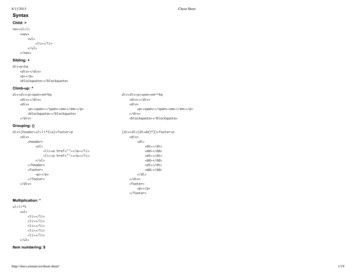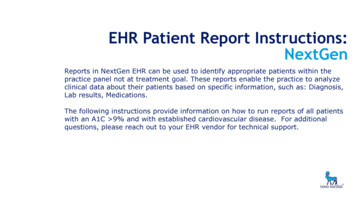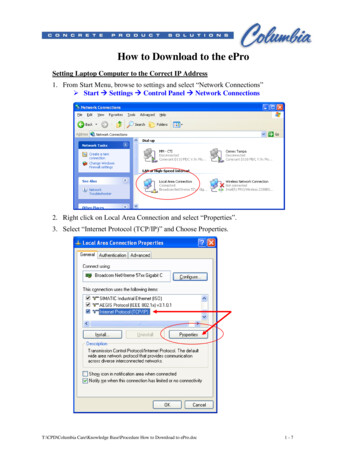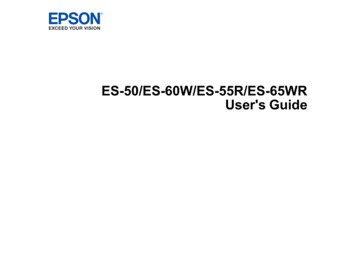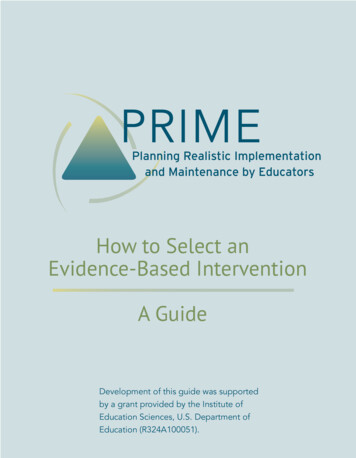
Transcription
PRIMEPlanning Realistic Implementationand Maintenance by EducatorsHow to Select anEvidence-Based InterventionA GuideDevelopment of this guide was supportedby a grant provided by the Institute ofEducation Sciences, U.S. Department ofEducation (R324A100051).
A Brief Introduction to Project PRIMEPRIME is a system of implementation supports designed to increase treatment integrity, the extent to which an intervention is implemented as planned. We know that evidence-based interventionsneed to be implemented with a high level of treatment integrityto maximize student outcomes; however research shows that mostimplementers struggle to maintain adequate levels of treatment integrity after just a few days. For this reason, school-based consultants should promote implementers’ levels of treatment integritythrough the utilization of PRIME supports.The evaluation of treatment integrity in applied settings is alsoan important factor in determining the functional relationship between interventions and student outcomes. Decisions about increasing or decreasing supports are data-based when treatmentintegrity data are considered in conjunction with student outcomedata. For more information about PRIME, the theoretical model behind PRIME, and treatment integrity, please see Chapters 1, 2, and 5of the PRIME Manual.The PRIME model assumes implementation of evidence- or research-based interventions. The purpose of this prerequisite guideis to provide a brief overview a four-step process for selecting evidence-based interventions to address specific student concerns.HOW TO SELECT AN EVIDENCE - BASED INTERVENTION: A GUIDE1
What Will This Guide Tell Me?PRIME is a system of implementation supports designed to increasethe extent to which an intervention is implemented as planned. Bestpractices indicate that school-based interventions should be supported by research, as these interventions have the most likelihoodof promoting positive student outcomes. However, it can be difficultto identify an appropriate evidence-based intervention for a student.Therefore, the purpose of this prerequisite guide is to outline a simple, four-step process for selecting evidence-based interventions toaddress specific student concerns. Familiarity with this process willhelp consultants feel more comfortable engaging in problem-solving consultation and implementing PRIME supports.What is an Evidence-Based Intervention?Throughout this guide and the PRIME Manual, “intervention” refersto a strategy, curriculum, or manualized program implemented withan individual student or group of students to prevent or remediate atarget problem. An evidence-based intervention is one that has beenshown, in controlled research studies, to be efficacious in improvingstudent outcomes (i.e., achievement or behavior). For this reason,evidence-based interventions are also commonly referred to as “research-based interventions.” When we refer to interventions in thePRIME Manual, we expect that evidence-based or research-basedinterventions are being employed. As they are rigorously examined,consultants and implementers (i.e., consultees) can be more confident that these interventions will prevent or remediate a targetproblem, compared to interventions that are untested.How to Select an Evidence-Based InterventionEvidence-based interventions need to be reviewed and selectedbased on the specific issues demonstrated by the target student(s).So the process for identifying an intervention includes identifyingthe student issue and evaluating intervention options. More specif-HOW TO SELECT AN EVIDENCE - BASED INTERVENTION: A GUIDE2
ically, the process of selecting an intervention can be broken downinto four steps:1. Identify the issue of concern, collect baseline data, anddevelop goals;2. Search the Internet, books, and primary resources forinterventions;3. Consider benefits and disadvantages of intervention options;and4. Select an appropriate evidence-based interventionStep 1: Identify the issue of concern, collect baseline data, anddevelop goalsTo select an intervention, the primary student concern must beclearly identified. As a part of a problem-solving consultation model,this will occur at the beginning of the consultation process, in theproblem identification stage. The target problem, whether academicor behavioral in nature, should be clearly defined and operationalized. For more information about how to identify student concerns,please see Problem-Solving Consultation: A Guide and Chapter 6 inthe PRIME Manual.Once the concern is defined, a method for assessing that concernshould be chosen and used to collect baseline data. This methodwill involve measuring a dimension of the concern (e.g., frequency, rate, duration) through direct observation or assessment. For instance, if behavior is a concern, observation data on the frequency of“call outs” may be assessed or if academic progress is a concern, thencurriculum-based measures may used to pinpoint the issue. Datacollected during these initial three to five observations is called“baseline data” because it represents the current level of functioning prior to intervention.Baseline data are critically important to the intervention selection process because the consultant and implementer use thosedata to determine an intervention goal. This goal should representHOW TO SELECT AN EVIDENCE - BASED INTERVENTION: A GUIDE3
the desired level of student functioning. A clear goal will allow theconsultant to engage in a targeted search for intervention that willhelp the student meet his/her specific goal.For more detailed information about choosing an assessmentmeasure, collecting and interpreting baseline data, and setting intervention goals, please see Chapter 6 of the PRIME Manual: Progress Monitoring.Step 2: Search the Internet, books, and primary resources forinterventionsWith a goal in mind, the search for an appropriate evidence-basedintervention can begin. There are many resources for finding suchinterventions. The organizations and agencies listed in Table 1(adapted from Frank & Kratochwill, 2008) maintain websites withinformation about specific intervention initiatives, which can facilitate finding interventions that align with student and school characteristics and needs. In addition, there are many handbooks andreference books that serve as excellent resources for interventionsto address academic, behavioral, and social and emotional goals.Information on these books is provided in Table 2.Table 1. Internet Resources for Evidence-Based InterventionsOrganization orAgencyNational Instituteof Child Health andHuman DevelopmentInitiativeNational ReadingPanelWhat WorksClearinghouseInstitute of Education (WWC) /SciencesDoing What Works(DWW)ScopeWebsitesReview of research onhow children learn tohttp://www.nationalread and information on readingpanel.org/Publievidence-based methods cations/summary.htmfor teaching readingPractice guides fories.ed.gov/ncee/wwcresearch-based practices (WWC) / videosandand tools to translateresearch-based practicesdww.ed.govto schoolsHOW TO SELECT AN EVIDENCE - BASED INTERVENTION: A GUIDE4
National Institute forLiteracyInformation andCommunicationSystem (LINCS)National Clearinghouse for EnglishOffice of EnglishAcquisition andLanguage AcquisitionInstructional Edu(OELA)cational Programs(NCELA)lincs.ed.gov/Resources for meetingthe instructional needsof English languagelearnerswww.ncela.gwu.eduInformation and resources for individual andclass- and school-widewww.interventioncenacademic and behavioral tral.orgissuesIntervention CentralInteractive training andevidence-based professional developmentiris.peabody.vanderbilt.resources for supporting edustudents with disabilitiesThe IRIS CenterDescriptions and modeling videos of educationalebi.missouri.eduevidence-based frameworks.Evidence-Based Intervention NetworkOnline resource for educators and researchersof scientific reviews ofvariety of programs forchildren in grades K-12Best Evidence EncyclopediaDivision for LearningDisabilities (CEC)Information onevidence-based literacypracticesTeaching LDOnline resource for educators of students withlearning disabilitiesHOW TO SELECT AN EVIDENCE - BASED INTERVENTION: A GUIDEwww.bestevidence.orgwww.teachingld.org/ld resources/default.htm5
Florida Center forReading ResearchInformation aboutresearch-based practices related to literacyinstruction and assessment for children inpre-school through 12thgradeOSEP TechnicalAssistance Center ofPositive BehavioralInterventions andSupportsInformation on implementing positivebehavior interventionand supports sponsoredby the Department ofEducationwww.fcrr.orgwww.pbis.orgTable 2. Book Resources for Evidence-Based InterventionTitleAuthor/Editorand YearChild and adolescenttherapy: Fourth edition:Cognitive-behavioralKendall (2011)proceduresDescriptionInformation pertaining to effective cognitivebehavioral approaches for treating frequently encountered child and adolescent disorders, includingtheory, research, and treatment manualsEvidence-based psychotherapies for childrenKazdin & Weiszand adolescents, Second (2010)EditionTreatment approaches for a broad range of social,emotional, and behavioral problems in childrenand adolescents, including conceptual foundations,interventions, and treatment manualsHandbook of evidence-based treatmentmanuals for childrenLeCroy (2008)and adolescents, SecondEditionTreatment manuals, as well as theoretical foundations and research support, for clinical disorders,social problems, and preventative interventionsO’Connor &Vadasy (2011)Research on and description of effective interventions for word recognition, spelling, fluency,vocabulary, comprehension, and writingHandbook of readinginterventionsHOW TO SELECT AN EVIDENCE - BASED INTERVENTION: A GUIDE6
Effective school interventions: Strategies forenhancing academicachievement and socialcompetenceRathvon (2008)Evidence-based interventions at the individual andclassroom level for academic and social problems;information on designing, implementing, andevaluating interventionsBehavioral interAkin-Little,ventions in schools:Little, Bray, &Evidence-Based PositiveKehle (2009)StrategiesInformation regarding behavioral interventionsat the primary, secondary, and tertiary preventionlevelsImplementingEvidence-BasedAcademic Interventionsin School SettingsResearch on and description of evidence-basedinterventions for math, literacy, and writing, andinformation concerning intervention implementation issuesRosenfield& Berninger(2009)In addition to the Internet and book resources, consultants orimplementers can gather recommendations from colleagues, andthen obtain information and supporting resources on recommendedinterventions directly from the publisher or author (a web-basedsearch will likely yield the publisher or author’s name). Althoughit can be challenging to obtain information on unpublished interventions directly from publishers and authors, unpublished interventions can be less costly than published ones. For example, oftendevelopers of unpublished interventions will forward school districts copies of manuals and training materials for a nominal fee(Kratochwill et al., 2008).Additional support for identifying possible interventions can beobtained through state and regional education support centers andconsultants. Publications concerning best practices in a specific field(e.g., Best Practices in School Psychology V, Thomas & Grimes, 2008)can also be accessed as sources of information regarding interventions for particular concerns.HOW TO SELECT AN EVIDENCE - BASED INTERVENTION: A GUIDE7
Step 3: Consider benefits and disadvantages of intervention optionsSelected interventions must be effective, but also align with theneeds of the student and the resources available for implementation (Sanetti & Gritter, 2010). Once consultants find a handful ofpotential interventions, they can gather information that helps determine which intervention is best suited for the primary concernand the setting. To do so, review the identified interventions basedon the following factors: (a) student characteristics, (b) contextualfactors, (c) evidence, and (d) practicality.Student Characteristics. The characteristics that need to be considered when reviewing interventions include the student’s goals anddemographics. The intervention should address the primary concernand at least one of the goals (typically the prioritized goal) identifiedin Step 1. In addition, ideally, the student should be similar in termsof disability, age, gender, race, and cultural background to those students who have been shown to benefit from the intervention. Do the goals of the intervention match the student’s needs? Is the student or class similar to those who have previouslybenefitted from the intervention? Does the disability, age, grade, gender, ethnicity, race, etc. ofthe students the intervention was designed for match thespecific target student? If not, can the intervention be adapted to meet the unique needs of the student or to make itmore culturally sensitive without significantly changing thecore components of the intervention?Contextual Factors. Important contextual factors refer to the matchbetween the setting in which the intervention was evaluated in research and the current setting of the student. These factors includethe location of the intervention (e.g., school setting), staff-studentratio, time of day/year, and administrative or parent support (Sanetti& Gritter, 2010).HOW TO SELECT AN EVIDENCE - BASED INTERVENTION: A GUIDE8
Has the intervention been shown in rigorous evaluations toproduce meaningful results in school settings that aresimilar to the context in which the intervention will beimplemented?Evidence. When reviewing interventions from Internet and primarysources, consider the levels of evidence found for the interventionsin documentation of their efficacy and effectiveness.PRIME TipEfficacy refers to the link between the intervention and positive outcomes in controlled research studies. Effectiveness refers to the linkbetween the intervention and positive outcomes in actual practicesettings, such as schools (Forman & Burke, 2008). Consideration ofboth is necessary for determining the level of evidentiary supportfor a possible intervention.Many Internet and primary resources provide interventions witha categorical label corresponding to the level of evidence demonstrated by the intervention. The particular labels will vary dependingon the evidence continuum utilized by the organization. Generally,categories correspond to no evidence, some evidence, or evidence foran intervention. One continuum of evidence proposed by Andrewsand Buettner (2002a) includes the following descriptors:§ Untested – Either there is no documentation that the intervention has been used or it has been used, but not evaluated.§ Promising – The intervention has been implemented and significant impact evaluations have been conducted. Data supportingthe intervention are promising. However, scientific rigor of evaluation is not sufficient. Undefined factors may be contributing tothe success of participants. Interventions supported with localdata from carefully administered and well-designed screeningor progress-monitoring systems may fall into this category ofevidence.HOW TO SELECT AN EVIDENCE - BASED INTERVENTION: A GUIDE9
§ Evidence Base – There is compelling evidence of effectiveness.Participant success can be attributed directly to the intervention.Evaluation studies have been replicated; there is scientific evidence that the approach will work for others in different environments.Evidence is a process and always under development. Some interventions will develop stronger support as research is conductedand more is learned about implementation of the intervention andsome interventions will fall from favor because new interventionswill display greater relative success. An intervention may even become discredited or show negative outcomes for certain educational applications.PRIME TipAdditional resources for understanding the evaluation of scientificevidence for interventions, particularly when conducting a literature search, can be found in:Identifying and implementing educational practices supported byrigorous evidence: A user friendly guide (U.S. Department of Education, 2003; evid/rigorousevid.pdf)What is scientifically based research? A guide for teachers (National Institute for Literacy, 2006; http://lincs.ed.gov/publications/pdf/science research.pdf)Practicality. Practicality pertains to the resources available in theschool to support the intervention. Information relevant to the practicality of intervention implementation includes the cost, staff training, space, staff availability, and time required for the intervention(Sanetti & Gritter, 2010).To document the resources available in the school, resourcemapping can be used to help analyze and subsequently secure resources prior to and during implementation of the intervention. Thiswill allow the consultant to compare the resources required for theHOW TO SELECT AN EVIDENCE - BASED INTERVENTION: A GUIDE10
intervention with those available for intervention implementationwithin the school. One method proposed by Andrews and Buettner(2002b) includes the following descriptors:§ Available – Detailed descriptions of implementation proceduresare available and clear. Training, curriculum materials, and othersupport materials needed for implementation are available.§ Affordable – The total cost of intervention materials and training are affordable given the school’s budget. Training time andsupport needed to implement the intervention are reasonableand affordable. The time commitment for administering the intervention is feasible.§ Feasible – The intervention is consistent with the interventionprovider’s and school’s vision and approach to meeting theneeds of students. The approach used is consistent with existingpolicies and procedures. Implementation will not create insurmountable challenges.Are there adequate resources available to: (a) purchase materialsneeded to implement the intervention, (b) support professional development to learn about the intervention, and (c) implement theintervention with integrity?Step 4: Select an appropriate evidence-based interventionOnce potential intervention options have been narrowed based onthe student’s characteristics and relevant contextual factors, consultants will need to consider the quality of evidence for an intervention in conjunction with the practicality of implementation, whichare discussed in Step 3. Andrews and Buettner (2002c) created adecision-making matrix to assist consultants in this process. Thismatrix displays the continuum of both evidence and practicality (seeFigure 2) and is described below.HOW TO SELECT AN EVIDENCE - BASED INTERVENTION: A GUIDE11
Figure 2. Evidence-Based Intervention Decision-Making Matrix (Andrews &Buettner, enceLow-------------------------------HighUntested andAvailablePromising andAvailableEvidence-Based andAvailableUntested andAffordablePromising andAffordableEvidence-Based andAffordableUntested andFeasiblePromising andFeasibleEvidence-Based andFeasibleSometimes, it is not possible to consider implementing interventions, even those with a strong evidence base because of practicalitybarriers. Interventions that are available, but are neither affordablenor feasible are not realistic for use in school settings. Interventionsthat are both available and affordable may have promise for implementation if they are feasible. Ideally, interventions will be implemented as designed. It is possible, however, that adaptations mayneed to be made to the intervention to accommodate the availableresources within the school (Kratochwill et al., 2008). Identifyingwhere each potential intervention falls within this matrix facilitatesthe selection of an intervention that is most likely to be successful.What Did I Learn?This guide provides an outline of the steps necessary to selectan evidence-based intervention. To find an appropriate intervention,consultants must first identify the student concern and search available resources for interventions that address this concern. Aspects ofinterventions under consideration, including student characteristicsand contextual factors, should be investigated further. Finally, an intervention should be chosen based on its evidence and practicality.HOW TO SELECT AN EVIDENCE - BASED INTERVENTION: A GUIDE12
ReferencesAkin-Little, A., Little, S. G., Bray, B. A., & Kehle, T. J. (2009). BehavioralInterventions in Schools: Evidence-Based Positive Strategies.Washington, DC: American Psychological Association.Andrews, D.A. & Buettner, C. K. (2002a). Evidence-based practice:Evaluating supporting evidence. Unpublished Manuscript.Ohio State University: Authors. Downloaded from: edpractice.pdfAndrews, D.A. & Buettner, C. K. (2002b). Evaluating the feasibility ofprevention and intervention approaches. Unpublished Manuscript. Ohio State University: Authors. Downloaded lity.pdfAndrews, D.A. & Buettner, C. K. (2002c). Evidence and feasibility inprogram selection. Unpublished Manuscript. Ohio StateUniversity: Authors. Downloaded from: tion.pdfFrank, J. L., & Kratochwill, T.R. (2008). School-based problem-solving consultation: Plotting a new course for evidence-basedresearch and practice in consultation. In W.P. Erchul & S.M.Sheridan (Eds.), Handbook of research in school consultation(pp.13-30). New York: Lawrence Erlbaum Associates.Forman, S. G., & Burke, C. R. (2008). Best practices in selecting animplementing evidence-based school interventions. In A.Thomas, & J. Grimes (Eds.), Best Practices in School PsychologyV (Vol. 3, pp. 799-811). Bethseda, MD: National Associationof School Psychologists.Kazdin, A. E. & Weisz, J. R. (Eds.). (2003). Evidence-based psychotherapies for children and adolescents. New York: Guilford Press.HOW TO SELECT AN EVIDENCE - BASED INTERVENTION: A GUIDE13
Kendall, P. C. (Ed.). (2011). Child and adolescent therapy: Fourth edition:Cognitive-behavioral procedures. New York: Guilford.Kratochwill, T.R., & Bergan, J.R. (1990). Behavioral consultation inapplied settings: An individual guide. New York: Plenum Press.Kratochwill, T. R., Volpiansky, P., Shernoff, E. S., & O’Connor, E. (2008).Evidence-based practices: A guide for education communities.Madison, Wisconsin: Wisconsin Department of PublicInstruction.LeCroy, C. W. (2008). Handbook of evidence-based treatment manualsfor children and adolescents. New York: Oxford UniversityPress.Nation, M., Crusto, C., Wandersman, A., Kumpfer, K. L., Seybolt, D.,Morrissey-Kane, E., et al. (2003). What works in prevention:Principles of effective prevention programs. AmericanPsychologist, 58, 449–456.National Institute for Literacy. (2006). What is scientifically basedresearch? A guide for teachers. Jessup, MD: ED Pubs.O’Connor, R. E., & Vadasy, P. F. (2011). Handbook of reading interventions. New York: Guilford PressRathvon, N. (2008). Effective School Interventions: Strategies forEnhancing Academic Achievement and Social Competence (2nd ed.).New York: Guilford.Rosenfield, S., & Berninger, V. W. (2009). ImplementingEvidence-Based Academic Interventions in School Settings.New York, NY: Oxford University Press.Sanetti, L. M. H., & Gritter, K. L. (2010). Evidence based interventions:Resources and guidance for educators. In A. Canter, L. Paige,HOW TO SELECT AN EVIDENCE - BASED INTERVENTION: A GUIDE14
& S. Shaw (Eds.), Helping Children at Home and School (3rded.). Bethesda, MD: National Association of SchoolPsychologists.Thomas, A., & Grimes, J. (2008). Best Practices in School Psychology V.Bethseda, MD: National Association of School Psychologists.U.S. Department of Education. (2003). Identifying and implementingeducational practices supported by rigorous evidence: A userfriendly guide. Washington DC: Author.HOW TO SELECT AN EVIDENCE - BASED INTERVENTION: A GUIDE15
Intervention Central Information and resourc-es for individual and class- and school-wide academic and behavioral issues www.interventioncen-tral.org The IRIS Center Interactive training and evidence-based pro-fessional development resources for supporting students with disabilities iris.peabody.vanderbilt. edu Evidence-Based In-tervention Network





